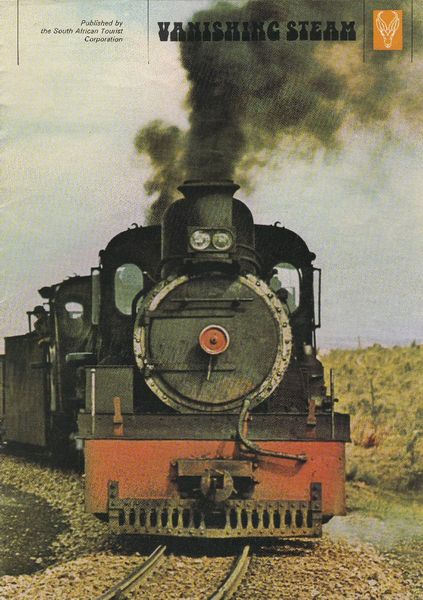
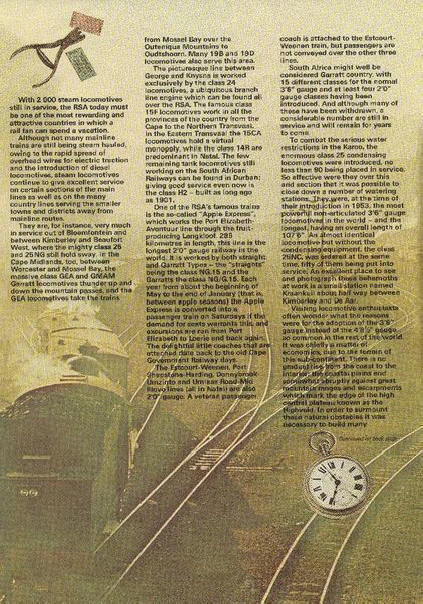
|
The text for
this page is at the bottom of article...... |
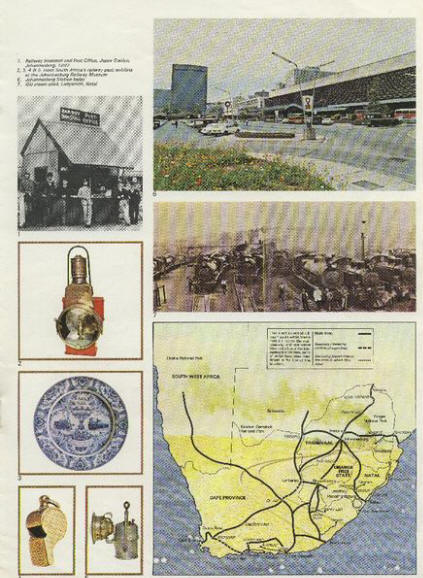
|
1.
Railway bookstall and Post Office,
Jeppe Station, Johannesburg, 1892.
2, 3, 4 & 5. From South Africa's railway past:
exhibits at the Johannesburg. Railway Museum 6.
Johannesburg Station today.
7. Old steam shed, Ladysmith, Natal. |
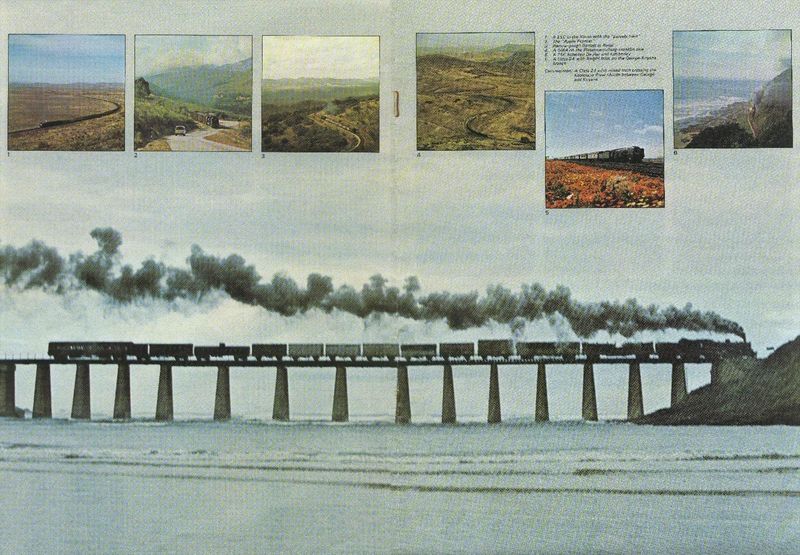
1. A 25C in the Karoo with the
"parcels train"'
2. The "Apple Express"
3. Narrow gauge Garratt in Natal
4. A GMA on the Pietermaritzburg-Franklin line 5. A
25C between De Aar and Kimberley
6. A Class 24 with freight train on the George-Knysna
branch
Centrespread: A Class 24 with mixed train crossing
the Kaaimans River Mouth between George and Knysna. |
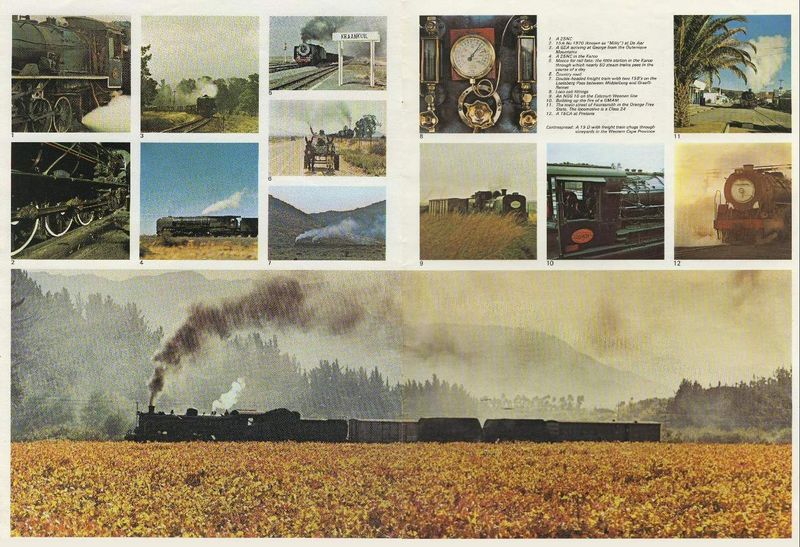
|
1. A 25NC
2. 15A No 1970 (known as "Milly") at De Aar 3. A GEA
arriving at George from the Outeniqua
Mountains
4. A 25NC in the Karoo
5. Mecca for rail fans: the little station in the
Karoo through which nearly 50 steam trains pass in
the course of a day
6. Country road
7. Double-headed freight train with two 198's on the
Lootsberg Pass between Middelburg and Graaff Reinet
8. Loco cab fittings
9. An NGG 16 on the Estcourt-Weenen line 10.
Building up the fire of a GMAM
11. The main street of Fauresmith in the Orange Free
State. The locomotive is a Class 24 12. A 15CA at
Pretoria
Centrespread: A 19 D with freight train chugs
through vineyards in the Western Cape Province. |
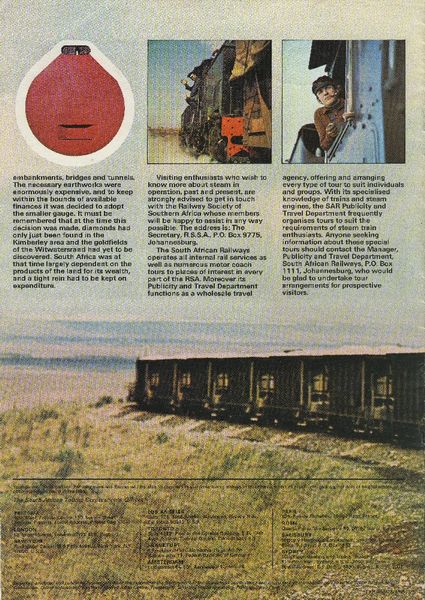
With 2 000 steam locomotives still in service, the
RSA today must be one of the most rewarding and
attractive countries in which a rail fan can spend a
vacation.
Although not many mainline trains are still being steam hauled, owing to
the rapid spread of overhead wires for electric
traction and the introduction of diesel locomotives,
steam locomotives continue to give excellent service
on certain sections of the main lines as well as on
the many country lines serving the smaller towns and
districts away from mainline routes.
They are, for instance, very much in service out of
Bloemfontein and between Kimberley and Beaufort
West, where the mighty class 25 and 25NG still hold
sway. In the Cape Midlands, too, between Worcester
and Mossel Bay, the massive class GEA and GMAM
Garratt locomotives thunder up and down the mountain
passes, and the GEA locomotives take the trains from
Mossel Bay over the Outeniqua Mountains to
Oudtshoorn. Many 19B and 19D locomotives also serve
this area.
The picturesque line between George and Knysna is worked
exclusively by the class 24 locomotives, a
ubiquitous branch line engine which can be found all
over the RSA.
The famous class 15F locomotives work in all the provinces of
the country from the Cape to the Northern Transvaal.
In the Eastern Transvaal the 15CA locomotives
hold a virtual monopoly, while the
class 14R are predominant in Natal.
The few remaining tank locomotives still working on the South
African Railways can be found in Durban; giving good
service even now is the class H2 - built as long ago
as 1901.
One of the RSA's famous trains is the so-called "Apple
Express", which works the Port Elizabeth-Avontuur
line through the fruit producing Langkloof. 285
kilometres in length, this line is the longest 2'0"
gauge railway in the world.
It is worked by both straight and Garratt Types - the
"straights" being the class NG.15 and the Garratts
the class NG/G.16. Each year from about the
beginning of May to the end of January (that is,
between apple seasons) the Apple, Express is
converted into a passenger train on Saturdays if the
demand for seats warrants this, and excursions are
run from Port Elizabeth to Loerie and back again.
The delightful little coaches that are attached date back to
the old Cape Government Railway days.
The
Estcourt-Weenen, Port Shepstone-Harding, Donnybrook-Umzinto
and Umlaas Road-Mid Ilovo' lines (all in Natal) are
also 2'0" gauge. A veteran passenger coach is
attached to the Estcourt-Weenen train, but
passengers are not conveyed over the other three
lines.
South Africa might well be considered Garratt country, with
15 different classes for the normal 3'6" gauge and
at least four 2'0" gauge classes having been
introduced. And although many of these have been
withdrawn, a considerable number are still in
service and will remain for years to come.
To combat the serious water restrictions in the Karoo, the
enormous class 25 condensing locomotives were
introduced, no less than 90 being placed in service.
So effective were they over this arid section that
it was possible to close down a number of watering
stations.
They were at the time of their introduction in 1953, the most
powerful non -articulated 3'6" gauge locomotive n
the world - and the longest, having an overall
length of 107'6". An almost identical locomotive but
without the condensing equipment, the class. 25NC,
was ordered at the same time, fifty of them being
put into service.
An excellent place to see and photograph these behemoths at
work is a small station named Kraankuil about half
way between Kimberley and De Aar.
Visiting locomotive enthusiasts often wonder what the reasons
were for the adoption of the 3'6" gauge instead of
the 4'8" gauge so common in the rest of the world.
It was chiefly a matter of economics, due to the
terrain of this sub-continent.
There is no gradual rise from the coast to the interior: the
coastal plains end somewhat abruptly against great
mountain ranges and escarpments which mark the edge
of the high central plateau known as the
Highveld.
In order to surmount these natural obstacles it was necessary
to build many embankments, bridges and tunnels The
necessary earthworks were enormously expensive, and
to keep within the bounds of available finances it
was decided to adopt the smaller gauge.
It must be remembered that at the time this decision was
made, diamonds had only just been found in the
Kimberley area and the goldfields of the
Witwatersrand had yet to be discovered. South Africa
was at that time largely dependent on the products
of the land for its wealth, and a tight rein had to
be kept on expenditure.
Visiting enthusiasts who wish to know more about steam in
operation, past and present, are strongly advised to
get in touch with the Railway Society of Southern
Africa whose members will be happy to assist in any
way possible. The address is: The Secretary, R.S.S.A.,
P.O. Box 9775, Johannesburg.
The South African Railways operates all internal rail
services as well as numerous motor coach tours to
places of interest in every part of the RSA.
Moreover its Publicity and Travel Department
functions as a wholesale travel agency, offering and
arranging every type of tour to suit individuals and
groups.
With its specialised knowledge of trains and steam engines,
the SAR Publicity and Travel Department frequently
organises tours to suit the requirements of steam
train enthusiasts. Anyone seeking information about
these special tours should contact the Manager,
Publicity and Travel Department, South African
Railways, P.O. Box 1111, Johannesburg, who would be
glad to undertake tour arrangements for prospective
visitors. |
|